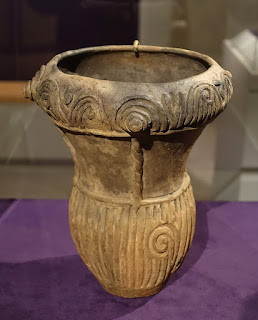 |
| Bangudae Petroglyphs, showing evidence of whaling |
 |
| Jeulmun Pottery Vessel |
In Japan, the situation was very similar. Here the early Jomon culture, also named after the comb-patterned pots used by its people, was flourishing. Here again we see fairly sedentary hunter-gatherers who had used bows and arrows (possibly tipped with poison) to hunt deer while also spending much of their time fishing and gathering nuts and berries.
 |
| Jomon Pottery Vessel |
Around 3900 the site of Sannai-Maruyama on the northern end of the island of Honshu in Japan was occupied. The inhabitants of this site may have used it as a seasonal residence, spending time foraging for food through the summer and autumn months and bringing back the bounty of the seas and forests to be stored in underground storage pits while their families lived in permanent dwellings throughout the harsh Japanese winter.
 |
| Jeulmun era jade ornaments |
Insofar as I can tell not much happens for nearly the next thousand years. The ways of life of the Jeulmun and Jomon peoples were quite stable. There seems to have been little warfare, although if they used poisoned weapons the usual signs of warfare might not be as apparent to archaeologists. The only real difficulty that they faced was the possibility that their populations would outgrow the carrying capacity of their environment. This seems to have happened eventually but it is nevertheless a credit to these people and their cultures that they managed to maintain their way of life for so long.
 |
| Site of Sannai-Maruyama, reconstructed |
Around the year 2500 the Early Jomon Period is held to have come to an end and the Middle Jomon Period began. This period saw the pit-houses become larger and the pottery become ever more elaborate. Some unusual looking clay figurines were also created and may have functioned as ritual objects. I’m always a little wary of the word “ritual”. It is an uncontested fact that our ancestors were extremely religious and even superstitious compared to our modern beliefs today. But there is a tendency to use the phrase “ritual” or “religious” whenever archaeologists come across an item that they do not understand. Because there is no real way of disproving it, we should be careful when using it. But use it we do. These figurines, known as Dogu, seem to be covered with patterns, which may indicate tattooing among the Jomon peoples.
 |
| Reconstructed site of Sannai-Maruyama |
Korean legends place the first emperor of Korea, Dangun Wanggeom, during this period. Supposedly he was the grandson of a bear who was born on Paektu Mountain in the north of Korea. This was held to be a sacred mountain and even today is held in reverence by the people in the region. North Korean official history suggests that Kim Jong-il was born there. Kim Jong-il also believed that Dangun was a historical figure and set his archaeologists to find his tomb. A tomb was duly found, but it is unlikely to be the tomb of Dangun. While the legends about Dangun are very interesting and shed much light on later Korean history, there is no direct evidence from this period for any state being founded. Perhaps this will change and I wanted to mention it here, but also to stress that for now, this is an entirely mythical episode.
 |
| Jomon Pottery Vessel |
In Japan, in what is now the Akita Prefecture of northern Japan, the Ōyu Stone Circles began to be used. These were a number of circles of small stones (rather than megaliths such as those of Stonehenge). The two largest circles were 46 and 42 metres in diameter. Around the edges, there were a number of wooden buildings and further out, some rubbish heaps, which would suggest that large numbers of people gathered here. The stone circles are aligned so that certain larger standing stones mark the position of the sunset on the summer solstice, making this an ancient astronomical monument. The monument seems to have been in use for several centuries at least.
This brings our very cursory view of the history of Japan and Korea to a close. There is indeed less to speak about here than in other regions. But we can see that both areas have formed stable pre-agricultural societies that would be well-placed for the eventual transition to full agriculture.
One final note when discussing Japanese archaeology. Sometimes when viewing older literature on the Paleolithic in Asia one will see Japanese artefacts that are vastly older than anything else in that region of Asia. This is because an amateur archaeologist, Shinichi Fujimura, was systematically faking ancient finds from the 1970’s all the way until the year 2000. This was caught and exposed by a brilliant piece of investigative journalism by a Japanese newspaper and the dates were revised substantially. Most of this affects the older pre-Jomon period in Japan, but it has some bearing on the dates of the Jomon, particularly the earlier phases, before the time span of this blog. So, if you come across older articles on Japanese archaeology bear in mind that they may be affected by this fraud.
Related Blog Posts:
Some Japanese and Korean history from 4000-2000BC
Some Japanese and Korean history from 2000-1000BC
Some Japanese and Korean history from 1000-500BC
No comments:
Post a Comment